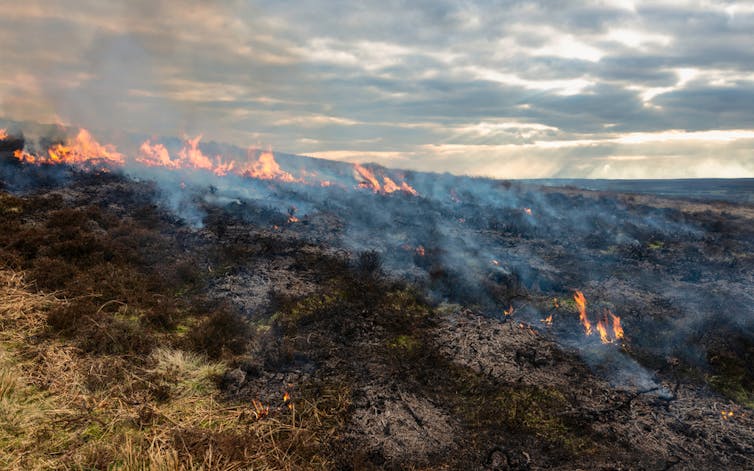Britain's endangered native ponies could help habitats recover – and Brexit offers an opportunity

Ponies grazing in a bluebell meadow in Dartmoor National Park, Devon. Helen Hotson/Shutterstock
06 April 2020
Dr Mariecia Fraser (Reader in Upland Agroecology and Lead Scientist at the Pwllpeiran Upland Research Centre) writes in The Conversation, about the wild ponies that have inhabited Britain for over 4,000 years but are in danger of dying out:
The UK’s semi-wild ponies are for the most part small, hairy characters whose physique and behaviour have been shaped by the windswept highlands they live in. Two breeds that have been roaming free since the Bronze Age are the Dartmoor Hill Pony, which is found on the hills and commons of Dartmoor in south-west England, and the Carneddau Mountain Pony, native to the Carneddau Mountains in Snowdonia, Wales.
But after thousands of years of surviving in some of Britain’s most remote areas, what happens to the ponies next will be decided in offices and meeting rooms hundreds of miles away. As it stands, these ponies are not classed as domesticated breeds, nor agricultural animals, nor even wildlife.
This ambiguity is a problem because these primitive ponies need urgent help. Census data indicate that the Dartmoor Hill Pony herd has declined from a high of 12,250 in the 1960s to 1,200 today. Meanwhile, there are only around 300 Carneddau Ponies left in Snowdonia.
The situation for wild horse populations is reversed in other countries. On American ranges, the current population of mustangs is estimated to be twice the “appropriate management level” as set by the Bureau of Land Management, while feral horse numbers have more than doubled since 2014 in Australia’s Kosciusko National Park.
In both cases, extreme measures such as culling have been proposed to control numbers, leading to public protests.
Read more: When introduced species are cute and loveable, culling them is a tricky proposition
But the feral populations in these high-profile cases are not “native”. They are instead descended from animals that escaped from, or were released by, European settlers in the 16th century. This means that they are, in ecological terms, alien species, and there is mounting scientific evidence that they are putting the ecosystems they now call home at risk through trampling vegetation and changing plant communities.
In sharp contrast, the numbers of native horses and ponies in the countries where many of these feral populations originated are dwindling.
Conservation grazing
In the UK, conservationists trying to safeguard the future of native ponies are hindered by the government’s own criteria for defining these animals. Because they live and reproduce outside of human control, Britain’s semi-wild ponies aren’t protected by breed societies or registers. So although they’re both “native” and “rare”, they don’t qualify as a “native breed at risk”, and so aren’t eligible for government support.
But indigenous ponies within their native ecosystems can have major benefits. Since Brexit is expected to lead to substantial changes in land use, the government should consider how useful these breeds might be, particularly in hilly and mountainous areas.
The new Agriculture Bill promises to pay farmers not for how much farmland they manage, but their ability to deliver public goods, like clean air and water. This is an opportunity to acknowledge and reward the grazing outcomes of livestock types other than sheep and cattle before it’s too late.
Read more: Agriculture Bill: here's what it means for farming and the environment after Brexit
Many upland areas of the UK and Europe have become dominated by plant species that grazing sheep and cattle don’t like to eat, such as purple moorgrass, bracken and rushes. As these plants tend to overrun the ecosystem, they drastically reduce biodiversity and increase the risk of destructive wildfires. This deterioration of grassland ecosystems has led to an increasing interest in conservation grazing, that is, the targeted use of domesticated or semi-feral grazers to improve biodiversity.

Semi-wild ponies have been largely neglected in research, but there is evidence that they prefer to graze many of the highly competitive plants that threaten grassland biodiversity. They also have rare genetics that have been shaped by natural and not artificial selection. This could mean they possess physical or behavioural adaptations that are no longer present in domesticated horses and ponies, which might make them more effective at managing native grasslands.
Britain’s struggling semi-wild ponies need help, but they also offer a unique opportunity to help restore habitats and allow a diverse range of species to flourish. As the UK government shifts its priorities for managing land after Brexit, it should seize the chance to protect their rare genetics and unleash the potential of upland ecosystems at the same time.![]()
Mariecia Fraser, Reader in Upland Agroecology, Aberystwyth University
This article is republished from The Conversation under a Creative Commons license. Read the original article.



